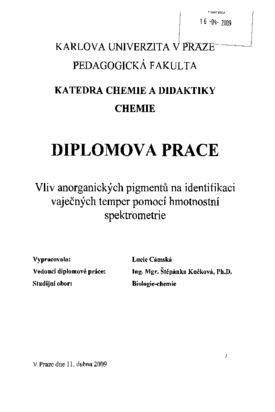Vliv anorganických pigmentů na identifikaci vaječných temper pomocí hmotnostní spektrometrie
The study of influence of inorganic pigments on the identification of egg tempera by mass spectrometry
diplomová práce (OBHÁJENO)

Zobrazit/
Trvalý odkaz
http://hdl.handle.net/20.500.11956/22793Identifikátory
SIS: 65384
Kolekce
- Kvalifikační práce [19116]
Autor
Vedoucí práce
Oponent práce
Hynek, Radovan
Fakulta / součást
Pedagogická fakulta
Obor
Učitelství všeobecně vzdělávacích předmětů pro základní školy a střední školy - biologie - Učitelství pro 2. stupeň základní školy - chemie
Katedra / ústav / klinika
Katedra chemie a didaktiky chemie
Datum obhajoby
3. 6. 2009
Nakladatel
Univerzita Karlova, Pedagogická fakultaJazyk
Čeština
Známka
Výborně
Úkolem této diplomové práce bylo zjistit, jakým způsobem ovlivňují anorganické pigmenty identifikaci vaječné a žloutkové tempery pomocí hmotnostní spektrometrie MALDI-TOF. Dalším úkolem bylo připravit sadu modelových barevných vrstev obsahujících deset vybraných anorganických pigmentů v kombinaci s vaječnou a žloutkovou temperou. Metodou peptidového mapování získat hmotnostní spektra připravených vzorků a porovnat vzniklé peptidové štěpy. Nakonec bylo možné od sebe odlišit vaječnou a žloutkovou temperu a zjistit, které z pigmentů nejvíce negativně ovlivnily identifikaci obou temper. V neposlední řadě byly získané hodnoty m/z z vaječné a žloutkové tempery použity ke zkvalitnění již existující databáze referenčních proteinových pojiv používané identifikaci proteinových pojiv obsažených v uměleckých dílech.
The aim of this diploma thesis is to find out in what way inorganic pigments influence the identification of egg and yolk tempera using mass spectrometry MALDITOF (matrix-assisted laser desorption/ionization time of flight). The other aim was to prepare a set of model color layers including ten inorganic pigments combined with the egg and yolk tempera. Using the method of peptide mass fingerprinting mass spectra of the samples were found out and the obtained peptides were compared. Finally the egg tempera was distinguished from the yolk tempera and it was found which pigments negatively influenced the identification of the temperas. The m/z values were found out for both temperas and they were used to upgrade database of the reference proteinaceous binders that have been used in art works.
